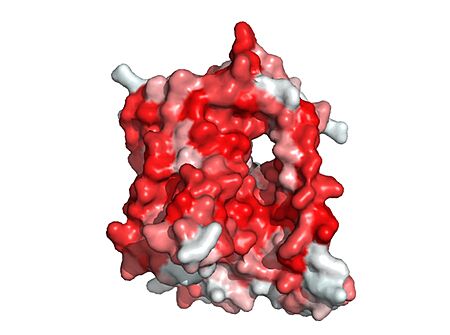Sandbox Reserved 1769
From Proteopedia
(Difference between revisions)
| Line 33: | Line 33: | ||
=== Sodium Binding Sites === | === Sodium Binding Sites === | ||
| - | To transport a single bile salt from the blood to the cytoplasm of the liver cell, two sodium ions are required to be bound to to NTCP in the open-pore state. This is because the transport of bile salts into the cell is so thermodynamically unfavorable that the reaction has to be coupled to the favorable transport of two sodium into into the cell. It is thus an example of secondary active transport (INSERT BLUE LINK). When the bile salts are released into the cell, the protein is then found in the inward facing conformation, in which the pore through which the bile salt had just passed is now closed to the extracellular side. | + | To transport a single bile salt from the blood to the cytoplasm of the liver cell, two sodium ions are required to be bound to to NTCP in the open-pore state. This is because the transport of bile salts into the cell is so thermodynamically unfavorable that the reaction has to be coupled to the favorable transport of two sodium into into the cell. It is thus an example of secondary active transport (INSERT BLUE LINK). When the bile salts are released into the cell, the protein is then found in the inward facing conformation, in which the pore through which the bile salt had just passed is now closed to the extracellular side. The residues interacting with the sodium ion in sodium binding site #1 include S105, N106, E257, and T123. The residues interacting with the sodium ion in sodium binding site #2 includes Q261 and Q68. Mutations to these significant residues inhibit the binding of sodium ions, and consequently, inhibit the transport of bile salts by NTCP. |
| + | <scene name='95/952698/Sodium_binding_sites/2'>Sodium Binding Sites</scene> - (self note - split up the two sodium binding sites so we have two green links instead of one) | ||
| - | <scene name='95/952698/Sodium_binding_sites/1'>TextToBeDisplayed</scene> | ||
=== Significant Residues === | === Significant Residues === | ||
Revision as of 17:49, 27 March 2023
Sodium-taurocholate Co-transporting Polypeptide
| |||||||||||
References
- ↑ Asami J, Kimura KT, Fujita-Fujiharu Y, Ishida H, Zhang Z, Nomura Y, Liu K, Uemura T, Sato Y, Ono M, Yamamoto M, Noda T, Shigematsu H, Drew D, Iwata S, Shimizu T, Nomura N, Ohto U. Structure of the bile acid transporter and HBV receptor NTCP. Nature. 2022 Jun; 606 (7916):1021-1026. DOI: 10.1038/s41586-022-04845-4.
- ↑ Goutam K, Ielasi FS, Pardon E, Steyaert J, Reyes N. Structural basis of sodium-dependent bile salt uptake into the liver. Nature. 2022 Jun;606(7916):1015-1020. DOI: 10.1038/s41586-022-04723-z.
- ↑ Park JH, Iwamoto M, Yun JH, Uchikubo-Kamo T, Son D, Jin Z, Yoshida H, Ohki M, Ishimoto N, Mizutani K, Oshima M, Muramatsu M, Wakita T, Shirouzu M, Liu K, Uemura T, Nomura N, Iwata S, Watashi K, Tame JRH, Nishizawa T, Lee W, Park SY. Structural insights into the HBV receptor and bile acid transporter NTCP. Nature. 2022 Jun;606(7916):1027-1031. DOI: 10.1038/s41586-022-04857-0.
- ↑ Liu H, Irobalieva RN, Bang-Sørensen R, Nosol K, Mukherjee S, Agrawal P, Stieger B, Kossiakoff AA, Locher KP. Structure of human NTCP reveals the basis of recognition and sodium-driven transport of bile salts into the liver. Cell Res. 2022 Aug;32(8):773-776. DOI: 10.1038/s41422-022-00680-4.
- ↑ Qi X, Li W. Unlocking the secrets to human NTCP structure. Innovation (Camb). 2022 Aug 1;3(5):100294. doi: 10.1016/j.xinn.2022.100294. DOI: 10.1016/j.xinn.2022.100294.
- ↑ Zhang X, Zhang Q, Peng Q, Zhou J, Liao L, Sun X, Zhang L, Gong T. Hepatitis B virus preS1-derived lipopeptide functionalized liposomes for targeting of hepatic cells. Biomaterials. 2014 Jul;35(23):6130-41. doi: 10.1016/j.biomaterials.2014.04.037. DOI: 10.1016/j.biomaterials.2014.04.037.
Student Contributors
- Ben Minor
- Maggie Samm
- Zac Stanley

